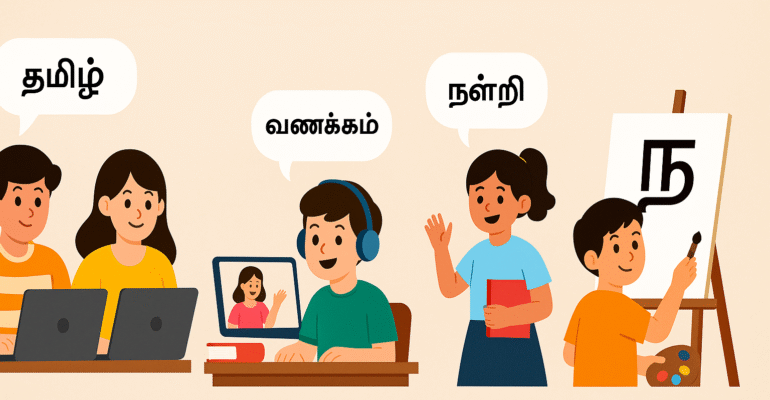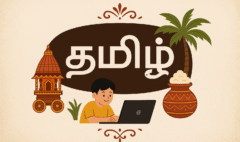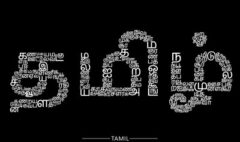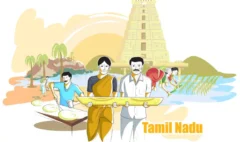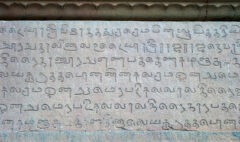The Best Tamilian Short Stories for Adults to Learn From
The Best Tamilian Short Stories for Adults to Learn From
The Best Tamilian Short Stories for Adults to Learn From: A Literary Path to Fluency
For the adult learner of the Tamil language, the journey from intermediate knowledge to advanced fluency is a challenging and deeply rewarding one. At this stage, you are ready to move beyond simple conversational phrases and to engage with the language in its more sophisticated and nuanced forms. There is no more powerful or enriching way to do this than by immersing yourself in the world of Tamil literature (தமிழ் இலக்கியம் – Tamiḻ ilakkiyam). While the great novels can seem daunting, the genre of the short story offers the perfect and most accessible gateway. The world of Tamil short stories for adults is a treasure trove of brilliant writing, complex characters, and profound insights into the culture, the society, and the very soul of the Tamil people.
The process of learning Tamil with fiction is a deeply immersive one. It exposes you to a richer vocabulary, more complex sentence structures, and the beautiful, literary register of the language. These short stories for language learners are more than just practice material; they are works of art that will stay with you long after you have finished reading. This guide will introduce you to some of the most iconic and influential short story writers in the Tamil language, providing a curated reading list that is perfect for the intermediate to advanced learner who is ready to take a deep dive into the literary heart of Tamil.
Why Short Stories are the Perfect Tool for Advanced Learners
Before we explore the authors, let’s understand why the short story is such an effective learning tool at this stage.
- Manageable Length: A short story can typically be read in a single sitting. This allows you to experience a complete, self-contained narrative without the long-term commitment of a novel.
- Literary Language: Short stories are a great introduction to the beauty of literary Tamil. You will encounter a richer and more poetic use of language than you would in a newspaper article or a casual conversation.
- Cultural Depth: The best short stories are a powerful window into the culture. They explore the complexities of family relationships, the tensions of social change, and the timeless questions of the human condition, all within a specific Tamil cultural context.
- Active Learning: Reading a short story is an active, engaging process. You will need to look up new words and to grapple with more complex grammatical structures, which is a powerful way to expand your skills.
The Masters of the Craft: Essential Authors and Their Stories
This is not an exhaustive list, but it represents some of the most important and influential figures in the history of the Tamil short story.
1. Pudhumaippithan (புதுமைப்பித்தன்) (1906-1948)
Why you should read him: Pudhumaippithan is widely regarded as the father and the revolutionary innovator of the modern Tamil short story. His writing was sharp, satirical, and decades ahead of its time. He broke away from the traditional, moralizing style of storytelling and wrote about the gritty, often harsh realities of everyday life.
Key Themes: Social hypocrisy, the struggles of the urban poor, existential questions, and a cynical but deeply humanistic view of the world.
A Story to Start With: “கடவுளும் கந்தசாமிப் பிள்ளையும்” (Kadavulum Kandasamy Pillaiyum) – “God and Kandasamy Pillai”. This is a brilliantly witty and satirical story in which an ordinary man, Kandasamy Pillai, has a chance encounter with God himself. Their conversation is a hilarious and profound critique of religious hypocrisy and human nature.
Language Level: Advanced. His language can be dense and his style is complex, but he is an absolutely essential writer for any serious student of Tamil literature.
2. Jayakanthan (ஜெயகாந்தன்) (1934-2015)
Why you should read him: Jayakanthan was a literary giant, a powerful and fearless writer who tackled bold and often controversial social issues. He was a Jnanpith awardee, the highest literary honor in India. His stories are known for their psychological depth and their powerful, realistic characters.
Key Themes: The lives of the urban working class, the complexities of human relationships, social justice, and a deep sense of psychological realism.
A Story to Start With: “அக்கினிப் பிரவேசம்” (Akkini Pravesam) – “Trial by Fire”. This was a groundbreaking and controversial story for its time. It deals with the aftermath of a young woman’s sexual assault and her mother’s compassionate and unconventional response. It is a powerful and deeply moving story that challenges societal norms.
Language Level: Intermediate to Advanced. His prose is clear and powerful, making him very accessible once you have a solid vocabulary.
3. Sundara Ramaswamy (சுந்தர ராமசாமி) (1931-2005)
Why you should read him: Sundara Ramaswamy was a master of modernism in Tamil literature. His writing is known for its philosophical depth, its precise and beautiful prose, and its exploration of the individual’s place in a changing world.
Key Themes: Existentialism, the search for meaning, the inner lives of his characters, and a deep sense of place.
A Story to Start With: “பள்ளம்” (Pallam) – “The Pit”. This is a poignant and beautifully written story about a man’s relationship with his aging father and his reflections on life, death, and the passage of time.
Language Level: Advanced. His vocabulary is rich and his sentences are beautifully crafted, making him a rewarding challenge for the serious learner.
4. Ki. Rajanarayanan (கி. ராஜநாராயணன்) (1923-2021)
Why you should read him: Affectionately known as “Ki. Ra.”, he was the master chronicler of the life and the language of the “karisal bhoomi”—the dry, southern region of Tamil Nadu. His stories are deeply rooted in the oral folk tradition.
Key Themes: Village life, folklore, the humor and the hardships of the rural people, and a celebration of the rustic, regional dialect of his homeland.
A Story to Start With: “கிடை” (Kidai) – “The Pen”. This is a beautiful and immersive story that captures the life of the shepherds and the semi-nomadic communities of the region.
Language Level: Intermediate to Advanced. The challenge here is not the complexity of the grammar, but the richness of the regional dialect and the folk vocabulary, which makes his work a unique and rewarding learning experience.
How to Approach Reading Fiction in Tamil
- Choose the Right Edition: Many of these classic stories are available in collections that have helpful footnotes or glossaries for difficult words.
- Don’t Be Afraid of the Dictionary: Keep a good dictionary handy, either a physical one or an app. The goal is not to understand every single word on the first pass, but to get the gist of the story. Circle the words you don’t know and look them up later.
- Read for Pleasure First: On your first reading, just try to enjoy the story. Don’t get too bogged down in the grammar.
- Re-read for Deeper Understanding: On a second reading, you can pay more attention to the sentence structure, the use of specific vocabulary, and the literary devices the author is using.
Conclusion: A Deeper Connection to the Language and the Culture
The world of Tamil short stories for adults is a vast and incredibly rewarding one. The process of learning Tamil with fiction is a journey that will challenge you, move you, and give you a profound and nuanced understanding of the Tamil language and the culture that it has so beautifully expressed. These short stories for language learners are more than just a tool for vocabulary building; they are a gateway to the very soul of the Tamil literary tradition. By engaging with these masterpieces, you are not just learning a language; you are participating in a rich and timeless conversation.

